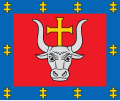Karmėlava
You can help expand this article with text translated from the corresponding article in Lithuanian. (June 2009) Click [show] for important translation instructions.
|
Karmėlava | |
|---|---|
Town | |
 | |
| Coordinates: 54°58′20″N 24°04′0″E / 54.97222°N 24.06667°E | |
| Country | |
| Ethnographic region | Aukštaitija |
| County | |
| Municipality | Kaunas district municipality |
| Population (2021) | |
• Total | 1,195 |
| Time zone | UTC+2 (EET) |
| • Summer (DST) | UTC+3 (EEST) |
Karmėlava is a small town in Kaunas district municipality, on the left bank of the Neris River, by the A6 (Kaunas-Zarasai-Daugpilis) highway, 6 km northeast of the northern border of Kaunas and near the second-busiest civil airport in Lithuania, Kaunas International Airport. In Karmėlava, there is also a full-time, self-study general education school, Karmėlavos Balio Buračo Gymnasium
Geography
[edit]A wide panorama of the Neris opens from the Karmėlava hillfort. Next to the town is a smaller settlement – Karmėlava II.
History
[edit]Karmėlava is one of the oldest settlements in Lithuania. The first inhabitants of Karmėlava appeared in the Stone Age, their campsite was on a wide dune near the village of Rykštynė.[1] There is a Karmėlava cemetery and the 14th-century Karmėlava hillfort.
Karmėlava was founded in 1387 by Grand Duke Władysław II Jagiełło of Lithuania. The area, called Kremilow, is mentioned in descriptions of the Die Littauischen Wegeberichte at the end of the 14th century.
In 1549, the Karmėlava manor belonged to Barbara Radziwiłł. Karmėlava is marked on the first map of the Grand Duchy of Lithuania in 1613.
In the 19th century, Karmėlava was a village Užusaliai rural municipality, Kaunas county.[2]
In 1812, during Napoleon's invasion of Russia, a corps under Marshall M. Nejas was stationed in Karmėlava as the army crossed the Nemunas near Kaunas. In the November Uprising, the village served as a base for rebels led by Mauricijus Prozor, who launched several attacks on Kaunas. In mid-April 1831, a major battle took place near nearby Turžėnai between the insurgents and the Russian imperial forces. Residents of Karmėlava also participated in the January Uprising.[1]
In 1918–1940, a girls' farm and home economics school operated in the former Karmėlava manor.
Residents
[edit]In 1789, there were 20 villages in Karmėlava.
| 1865[3] | 1923[4] | 1959 | 1970 | 1977 | 1979 |
|---|---|---|---|---|---|
| 190 | 470 | 1543 | 2584 | 3480 | 3664 |
| 1985 | 1989 | 2001 | 2011[5] | 2021 | - |
| 3375 | 1296 | 2886 | 1395 | 1195 | - |
Coat of arms
[edit]In 1720, the governor of Karmėlava, Jonas Mykolas Poklevskis Koziela, granted this state-owned estate the privilege of a market. Jews were allowed to settle in the town. On March 17, 1792, the last king of the Polish-Lithuanian Commonwealth, Stanisław August Poniatowski, granted the town Magdeburg rights and a coat of arms.[1] On November 24, 1998, the decree of the President of Lithuania confirmed the coat of arms of Karmėlava.
Economics
[edit]The main economic unit is the Kaunas International Airport and its related aviation companies ("Apatas", "Aviakompanija Lietuva", "Ryanair", "Wizz Air"), as well as the Kaunas Air Traffic Control Center, Kaunas Territorial Customs Office and the State Border Guard Service. The production of furniture (the company "Magdaris"), windows and doors ("Gipura"), bread and pastry products ("Mentora ir Ko", "Baltasis pyragas") have also been developed.
Kaunas International Airport
[edit]Kaunas Airport has been operating in Karmėlava since 1988, and in 2000 the Baltic Air Surveillance Network and Kaunas Aviation Meteorological Station were established here. Radar information about the airspace over the Baltic States collected in Karmėlava and is sent to the NATO Joint Air Operations Center in Germany.
Sport
[edit]Karmėlava has a football team called FK Neris Karmėlava.
References
[edit]- ^ a b c "Istorija | Karmėlavos seniūnija". karmelava.eu (in Lithuanian). Archived from the original on 2016-03-24. Retrieved 2025-10-28.
- ^ Kormiałów. Geographical Dictionary of the Kingdom of Poland. 1883. p. 403.
- ^ "НЭБ - Национальная электронная библиотека". rusneb.ru - Национальная электронная библиотека (in Russian). Retrieved 2025-10-28.
- ^ "ePaveldas". www.epaveldas.lt (in Lithuanian). Retrieved 2025-10-28.
- ^ "Wayback Machine" (PDF). statistics.bookdesign.lt. Archived from the original (PDF) on 2022-04-08. Retrieved 2025-10-28.
External links
[edit]- Karmėlava Balys Buračas Secondary School website Archived 2012-03-20 at the Wayback Machine


